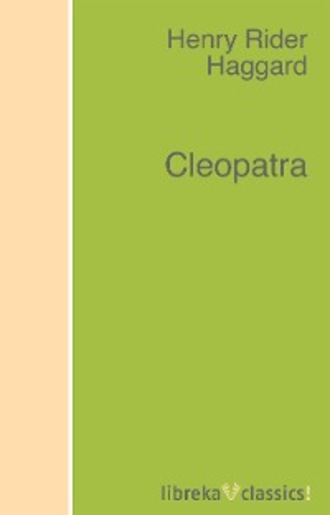
Полная версия
Cleopatra


Titel: Cleopatra
von ca. 337-422 Faxian, Sir Samuel White Baker, Sax Rohmer, Bernardin de Saint-Pierre, Maria Edgeworth, Saint Sir Thomas More, Herodotus, L. Mühlbach, Herbert Allen Giles, G. K. Chesterton, Algernon Charles Swinburne, Rudyard Kipling, A. J. O'Reilly, William Bray, O. Henry, graf Leo Tolstoy, Anonymous, Lewis Wallace, Johann Wolfgang von Goethe, Edgar Allan Poe, Jack London, Elizabeth Cleghorn Gaskell, Jules Verne, Frank Frankfort Moore, Susan Fenimore Cooper, Anthony Trollope, Henry James, T. Smollett, Thomas Burke, Emma Goldman, George Eliot, Henry Rider Haggard, Baron Thomas Babington Macaulay Macaulay, A. Maynard Barbour, Edmund Burke, Gerold K. Rohner, Bernard Shaw, Sir Joshua Reynolds, Bret Harte, Nathaniel Hawthorne, Jerome K. Jerome, Isabella L. Bird, Christoph Martin Wieland, Rainer Maria Rilke, Ludwig Anzengruber, Freiherr von Ludwig Achim Arnim, G. Harvey Ralphson, John Galsworthy, George Sand, Pierre Loti, Fyodor Dostoyevsky, Giambattista Basile, Homer, John Webster, P. G. Wodehouse, William Shakespeare, Edward Payson Roe, Sir Walter Raleigh, Victor [pseud.] Appleton, Arnold Bennett, James Fenimore Cooper, James Hogg, Richard Harding Davis, Ernest Thompson Seton, William MacLeod Raine, E. Phillips Oppenheim, Maksim Gorky, Henrik Ibsen, George MacDonald, Sir Max Beerbohm, Lucy Larcom, Various, Sir Robert S. Ball, Charles Darwin, Charles Reade, Adelaide Anne Procter, Joseph Conrad, Joel Chandler Harris, Joseph Crosby Lincoln, Alexander Whyte, Kate Douglas Smith Wiggin, James Lane Allen, Richard Jefferies, Honoré de Balzac, Wilhelm Busch, General Robert Edward Lee, Charles Dickens, Wilkie Collins, David Cory, Booth Tarkington, George Rawlinson, Sir Arthur Conan Doyle, Dinah Maria Mulock Craik, Christopher Evans, Thomas Henry Huxley, Mary Roberts Rinehart, Erskine Childers, Alice Freeman Palmer, Florence Converse, William Congreve, Stephen Crane, Madame de La Fayette, United States. Army. Corps of Engineers. Manhattan District, Willa Sibert Cather, Anna Katharine Green, Oliver Wendell Holmes, Charlotte M. Brame, Alphonse Daudet, Booker T. Washington, Clemens Brentano, Sylvester Mowry, Geoffrey Chaucer, Ellen Anderson Gholson Glasgow, Gail Hamilton, William Roscoe Thayer, Margaret Wade Campbell Deland, Rafael Sabatini, Archibald Henderson, Albert Payson Terhune, George Wharton James, Padraic Colum, James MacCaffrey, John Albert Macy, Annie Sullivan, Helen Keller, Walter Pater, Sir Richard Francis Burton, Baron de Jean-Baptiste-Antoine-Marcelin Marbot, Aristotle, Gustave Flaubert, 12th cent. de Troyes Chrétien, Valentine Williams, Thomas Wentworth Higginson, Alexandre Dumas fils, John Gay, Andrew Lang, Hester Lynch Piozzi, Jeffery Farnol, Alexander Pope, George Henry Borrow, Mark Twain, Francis Bacon, Margaret Pollock Sherwood, Henry Walter Bates, Thornton W. Burgess, Edmund G. Ross, William Alexander Linn, Voltaire, Giles Lytton Strachey, Henry Ossian Flipper, Émile Gaboriau, Arthur B. Reeve, Hugh Latimer, Baron Edward Bulwer Lytton Lytton, Benito Pérez Galdós, Robert Smythe Hichens, Niccolò Machiavelli, Prosper Mérimée, Ivan Sergeevich Turgenev, Anatole Cerfberr, Jules François Christophe, Victor Cherbuliez, Edgar B. P. Darlington, David Grayson, Mihai Nadin, Helen Beecher Long, Plutarch, Harriet Beecher Stowe, Margaret E. Sangster, Herman Melville, John Keats, Fannie Isabel Sherrick, Maurice Baring, William Terence Kane, Mary Russell Mitford, Henry Drummond, Rabindranath Tagore, Hubert Howe Bancroft, Charlotte Mary Yonge, William Dean Howells, Jesse F. Bone, Basil Hall Chamberlain, William Makepeace Thackeray, Samuel Butler, Frances Hodgson Burnett, E. Prentiss, Sir Walter Scott, Alexander K. McClure, David Livingstone, Bram Stoker, Victor Hugo, Patañjali, Amelia Ruth Gere Mason, Bertrand Russell, Alfred Russel Wallace, Molière, Robert Louis Stevenson, Simona Sumanaru, Michael Hart, Edmund Gosse, Samuel Smiles, Pierre Corneille, Clarence Edward Mulford, Mrs. Oliphant, George Pope Morris, Aristophanes, baron de Etienne-Léon Lamothe-Langon, William Morris, Henry David Thoreau, E. C. Bentley, Samuel Taylor Coleridge, Hippolyte Taine, Pedro Calderón de la Barca, John Philip Sousa, Wilhelm Grimm, Jacob Grimm, William Gardner, J. M. Judy, E. M. Forster, Percival Lowell, Alexandre Dumas père, William Greenwood, John Dryden, William T. Sherman, John Kendrick Bangs, Burton Egbert Stevenson, Eugene Wood, John Arbuthnot, Sir Richard Steele, Sir George Otto Trevelyan, William Charles Henry Wood, Marcel Proust, Philip Henry Sheridan, Abraham Lincoln, John Pinkerton, Thomas Hardy, Gotthold Ephraim Lessing, Oliver Goldsmith, Freiherr von der Friedrich Trenck, Eugene Field, Charles Dudley Warner, Andrew Everett Durham, Emily Dickinson, Emperor of Rome Marcus Aurelius, Edgar Wallace, Annie Roe Carr, Eleanor Stackhouse Atkinson, George McKinnon Wrong, Heinrich Zschokke, Harold Howland, Grace S. Richmond, Louisa May Alcott, Thomas Edwards, William Kirby, John McElroy
ISBN 978-3-7429-2667-8
Alle Rechte vorbehalten.
Es ist ohne vorherige schriftliche Erlaubnis nicht gestattet, dieses Werk im Ganzen oder in Teilen zu vervielfältigen oder zu veröffentlichen.
CLEOPATRA
by H. Rider Haggard
Contents
DEDICATION AUTHOR'S NOTE CLEOPATRA INTRODUCTION BOOK I—THE PREPARATION OF HARMACHIS CHAPTER I CHAPTER II CHAPTER III CHAPTER IV CHAPTER V CHAPTER VI CHAPTER VII BOOK II—THE FALL OF HARMACHIS CHAPTER I CHAPTER II CHAPTER III CHAPTER IV CHAPTER V CHAPTER VI CHAPTER VII CHAPTER VIII CHAPTER IX CHAPTER X CHAPTER XI CHAPTER XII CHAPTER XIII CHAPTER XIV CHAPTER XV CHAPTER XVI BOOK III—THE VENGEANCE OF HARMACHIS CHAPTER I CHAPTER II CHAPTER III CHAPTER IV CHAPTER V CHAPTER VI CHAPTER VII CHAPTER VIII CHAPTER IX CHAPTER X
DEDICATION
My dear Mother,
I have for a long while hoped to be allowed to dedicate some book of mine to you, and now I bring you this work, because whatever its shortcomings, and whatever judgment may be passed upon it by yourself and others, it is yet the one I should wish you to accept.
I trust that you will receive from my romance of "Cleopatra" some such pleasure as lightened the labour of its building up; and that it may convey to your mind a picture, however imperfect, of the old and mysterious Egypt in whose lost glories you are so deeply interested.
Your affectionate and dutiful Son,
H. Rider Haggard.
January 21, 1889.
AUTHOR'S NOTE
The history of the ruin of Antony and Cleopatra must have struck many students of the records of their age as one of the most inexplicable of tragic tales. What malign influence and secret hates were at work, continually sapping their prosperity and blinding their judgment? Why did Cleopatra fly at Actium, and why did Antony follow her, leaving his fleet and army to destruction? An attempt is made in this romance to suggest a possible answer to these and some other questions.
The reader is asked to bear in mind, however, that the story is told, not from the modern point of view, but as from the broken heart and with the lips of an Egyptian patriot of royal blood; no mere beast-worshipper, but a priest instructed in the inmost mysteries, who believed firmly in the personal existence of the gods of Khem, in the possibility of communion with them, and in the certainty of immortal life with its rewards and punishments; to whom also the bewildering and often gross symbolism of the Osirian Faith was nothing but a veil woven to obscure secrets of the Sanctuary. Whatever proportion of truth there may have been in their spiritual claims and imaginings, if indeed there was any, such men as the Prince Harmachis have been told of in the annals of every great religion, and, as is shown by the testimony of monumental and sacred inscriptions, they were not unknown among the worshippers of the Egyptian Gods, and more especially of Isis.
Unfortunately it is scarcely possible to write a book of this nature and period without introducing a certain amount of illustrative matter, for by no other means can the long dead past be made to live again before the reader's eyes with all its accessories of faded pomp and forgotten mystery. To such students as seek a story only, and are not interested in the faith, ceremonies, or customs of the Mother of Religion and Civilisation, ancient Egypt, it is, however, respectfully suggested that they should exercise the art of skipping, and open this tale at its Second Book.
That version of the death of Cleopatra has been preferred which attributes her end to poison. According to Plutarch its actual manner is very uncertain, though popular rumour ascribed it to the bite of an asp. She seems, however, to have carried out her design under the advice of that shadowy personage, her physician, Olympus, and it is more than doubtful if he would have resorted to such a fantastic and uncertain method of destroying life.
It may be mentioned that so late as the reign of Ptolemy Epiphanes, pretenders of native blood, one of whom was named Harmachis, are known to have advanced their claims to the throne of Egypt. Moreover, there was a book of prophecy current among the priesthood which declared that after the nations of the Greeks the God Harsefi would create the "chief who is to come." It will therefore be seen that, although it lacks historical confirmation, the story of the great plot formed to stamp out the dynasty of the Macedonian Lagidae and place Harmachis on the throne is not in itself improbable. Indeed, it is possible that many such plots were entered into by Egyptian patriots during the long ages of their country's bondage. But ancient history tells us little of the abortive struggles of a fallen race.
The Chant of Isis and the Song of Cleopatra, which appear in these pages, are done into verse from the writer's prose by Mr. Andrew Lang, and the dirge sung by Charmion is translated by the same hand from the Greek of the Syrian Meleager.
CLEOPATRA
INTRODUCTION
In the recesses of the desolate Libyan mountains that lie behind the temple and city of Abydus, the supposed burying place of the holy Osiris, a tomb was recently discovered, among the contents of which were the papyrus rolls whereupon this history is written. The tomb itself is spacious, but otherwise remarkable only for the depth of the shaft which descends vertically from the rock-hewn cave, that once served as the mortuary chapel for the friends and relatives of the departed, to the coffin-chamber beneath. This shaft is no less than eighty-nine feet in depth. The chamber at its foot was found to contain three coffins only, though it is large enough for many more. Two of these, which in all probability inclosed the bodies of the High Priest, Amenemhat, and of his wife, father and mother of Harmachis, the hero of this history, the shameless Arabs who discovered them there and then broke up.
The Arabs broke the bodies up. With unhallowed hands they tore the holy Amenemhat and the frame of her who had, as it is written, been filled with the spirit of the Hathors—tore them limb from limb, searching for treasure amidst their bones—perhaps, as is their custom, selling the very bones for a few piastres to the last ignorant tourist who came their way, seeking what he might destroy. For in Egypt the unhappy, the living find their bread in the tombs of the great men who were before them.
But as it chanced, some little while afterwards, one who is known to this writer, and a doctor by profession, passed up the Nile to Abydus, and became acquainted with the men who had done this thing. They revealed to him the secret of the place, telling him that one coffin yet remained entombed. It seemed to be the coffin of a poor person, they said, and therefore, being pressed for time, they had left it unviolated. Moved by curiosity to explore the recesses of a tomb as yet unprofaned by tourists, my friend bribed the Arabs to show it to him. What ensued I will give in his own words, exactly as he wrote it to me:
"I slept that night near the Temple of Seti, and started before daybreak on the following morning. With me were a cross-eyed rascal named Ali—Ali Baba I named him—the man from whom I got the ring which I am sending you, and a small but choice assortment of his fellow thieves. Within an hour after sunrise we reached the valley where the tomb is. It is a desolate place, into which the sun pours his scorching heat all the long day through, till the huge brown rocks which are strewn about become so hot that one can scarcely bear to touch them, and the sand scorches the feet. It was already too hot to walk, so we rode on donkeys, some way up the valley—where a vulture floating far in the blue overhead was the only other visitor—till we came to an enormous boulder polished by centuries of action of sun and sand. Here Ali halted, saying that the tomb was under the stone. Accordingly, we dismounted, and, leaving the donkeys in charge of a fellah boy, went up to the rock. Beneath it was a small hole, barely large enough for a man to creep through. Indeed it had been dug by jackals, for the doorway and some part of the cave were entirely silted up, and it was by means of this jackal hole that the tomb had been discovered. Ali crept in on his hands and knees, and I followed, to find myself in a place cold after the hot outside air, and, in contrast with the light, filled with a dazzling darkness. We lit our candles, and, the select body of thieves having arrived, I made an examination. We were in a cave the size of a large room, and hollowed by hand, the further part of the cave being almost free from drift-dust. On the walls are religious paintings of the usual Ptolemaic character, and among them one of a majestic old man with a long white beard, who is seated in a carved chair holding a wand in his hand.[*] Before him passes a procession of priests bearing sacred images. In the right hand corner of the tomb is the shaft of the mummy-pit, a square-mouthed well cut in the black rock. We had brought a beam of thorn-wood, and this was now laid across the pit and a rope made fast to it. Then Ali—who, to do him justice, is a courageous thief—took hold of the rope, and, putting some candles into the breast of his robe, placed his bare feet against the smooth sides of the well and began to descent with great rapidity. Very soon he had vanished into blackness, and the agitation of the cord alone told us that anything was going on below. At last the rope ceased shaking and a faint shout came rumbling up the well, announcing Ali's safe arrival. Then, far below, a tiny star of light appeared. He had lit the candle, thereby disturbing hundreds of bats that flitted up in an endless stream and as silently as spirits. The rope was hauled up again, and now it was my turn; but, as I declined to trust my neck to the hand-over-hand method of descent, the end of the cord was made fast round my middle and I was lowered bodily into those sacred depths. Nor was it a pleasant journey, for, if the masters of the situation above had made any mistake, I should have been dashed to pieces. Also, the bats continually flew into my face and clung to my hair, and I have a great dislike of bats. At last, after some minutes of jerking and dangling, I found myself standing in a narrow passage by the side of the worthy Ali, covered with bats and perspiration, and with the skin rubbed off my knees and knuckles. Then another man came down, hand over hand like a sailor, and as the rest were told to stop above we were ready to go on. Ali went first with his candle—of course we each had a candle—leading the way down a long passage about five feet high. At length the passage widened out, and we were in the tomb-chamber: I think the hottest and most silent place that I ever entered. It was simply stifling. This chamber is a square room cut in the rock and totally devoid of paintings or sculpture. I held up the candles and looked round. About the place were strewn the coffin lids and the mummied remains of the two bodies that the Arabs had previously violated. The paintings on the former were, I noticed, of great beauty, though, having no knowledge of hieroglyphics, I could not decipher them. Beads and spicy wrappings lay around the remains, which, I saw, were those of a man and a woman.[+] The head had been broken off the body of the man. I took it up and looked at it. It had been closely shaved—after death, I should say, from the general indications—and the features were disfigured with gold leaf. But notwithstanding this, and the shrinkage of the flesh, I think the face was one of the most imposing and beautiful that I ever saw. It was that of a very old man, and his dead countenance still wore so calm and solemn, indeed, so awful a look, that I grew quite superstitious (though as you know, I am pretty well accustomed to dead people), and put the head down in a hurry. There were still some wrappings left upon the face of the second body, and I did not remove them; but she must have been a fine large woman in her day.
"'There the other mummy,' said Ali, pointing to a large and solid case that seemed to have been carelessly thrown down in a corner, for it was lying on its side.
"I went up to it and carefully examined it. It was well made, but of perfectly plain cedar-wood—not an inscription, not a solitary God on it.
"'Never see one like him before,' said Ali. 'Bury great hurry, he no "mafish," no "fineesh." Throw him down here on side.'
"I looked at the plain case till at last my interest was thoroughly aroused. I was so shocked by the sight of the scattered dust of the departed that I had made up my mind not to touch the remaining coffin—but now my curiosity overcame me, and we set to work.
"Ali had brought a mallet and a cold chisel with him, and, having set the coffin straight, he began upon it with all the zeal of an experienced tomb-breaker. And then he pointed out another thing. Most mummy-cases are fastened by four little tongues of wood, two on either side, which are fixed in the upper half, and, passing into mortices cut to receive them in the thickness of the lower half, are there held fast by pegs of hard wood. But this mummy case had eight such tongues. Evidently it had been thought well to secure it firmly. At last, with great difficulty, we raised the massive lid, which was nearly three inches thick, and there, covered over with a deep layer of loose spices (a very unusual thing), was the body.
"Ali looked at it with open eyes—and no wonder. For this mummy was not as other mummies are. Mummies in general lie upon their backs, as stiff and calm as though they were cut from wood; but this mummy lay upon its side, and, the wrappings notwithstanding, its knees were slightly bent. More than that, indeed, the gold mask, which, after the fashion of the Ptolemaic period, had been set upon the face, had worked down, and was literally pounded up beneath the hooded head.
"It was impossible, seeing these things, to avoid the conclusion that the mummy before us had moved with violence since it was put in the coffin.
"'Him very funny mummy. Him not "mafish" when him go in there,' said Ali.
"'Nonsense!' I said. 'Who ever heard of a live mummy?'
"We lifted the body out of the coffin, nearly choking ourselves with mummy dust in the process, and there beneath it half hidden among the spices, we made our first find. It was a roll of papyrus, carelessly fastened and wrapped in a piece of mummy cloth, having to all appearance been thrown into the coffin at the moment of closing.[*]
"Ali eyed the papyrus greedily, but I seized it and put it in my pocket, for it was agreed that I was to have all that might be discovered. Then we began to unwrap the body. It was covered with very broad strong bandages, thickly wound and roughly tied, sometimes by means of simple knots, the whole working the appearance of having been executed in great haste and with difficulty. Just over the head was a large lump. Presently, the bandages covering it were off, and there, on the face, lay a second roll of papyrus. I put down my hand to lift it, but it would not come away. It appeared to be fixed to the stout seamless shroud which was drawn over the whole body, and tied beneath the feet—as a farmer ties sacks. This shroud, which was also thickly waxed, was in one piece, being made to fit the form like a garment. I took a candle and examined the roll and then I saw why it was fast. The spices had congealed and glued it to the sack-like shroud. It was impossible to get it away without tearing the outer sheets of papyrus.[*]
"At last, however, I wrenched it loose and put it with the other in my pocket.
"Then we went on with our dreadful task in silence. With much care we ripped loose the sack-like garment, and at last the body of a man lay before us. Between his knees was a third roll of papyrus. I secured it, then held down the light and looked at him. One glance at his face was enough to tell a doctor how he had died.
"This body was not much dried up. Evidently it had not passed the allotted seventy days in natron, and therefore the expression and likeness were better preserved than is usual. Without entering into particulars, I will only say that I hope I shall never see such another look as that which was frozen on this dead man's face. Even the Arabs recoiled from it in horror and began to mutter prayers.
"For the rest, the usual opening on the left side through which the embalmers did their work was absent; the finely-cut features were those of a person of middle age, although the hair was already grey, and the frame was that of a very powerful man, the shoulders being of an extraordinary width. I had not time to examine very closely, however, for within a few seconds from its uncovering, the unembalmed body began to crumble now that it was exposed to the action of the air. In five or six minutes there was literally nothing left of it but a wisp of hair, the skull, and a few of the larger bones. I noticed that one of the tibiæ—I forget if it was the right or the left—had been fractured and very badly set. It must have been quite an inch shorter than the other.










